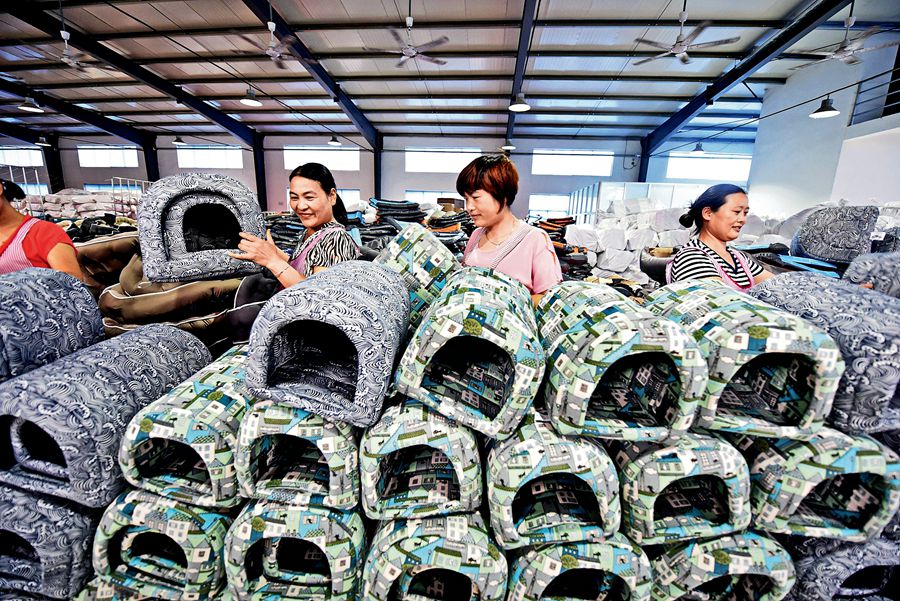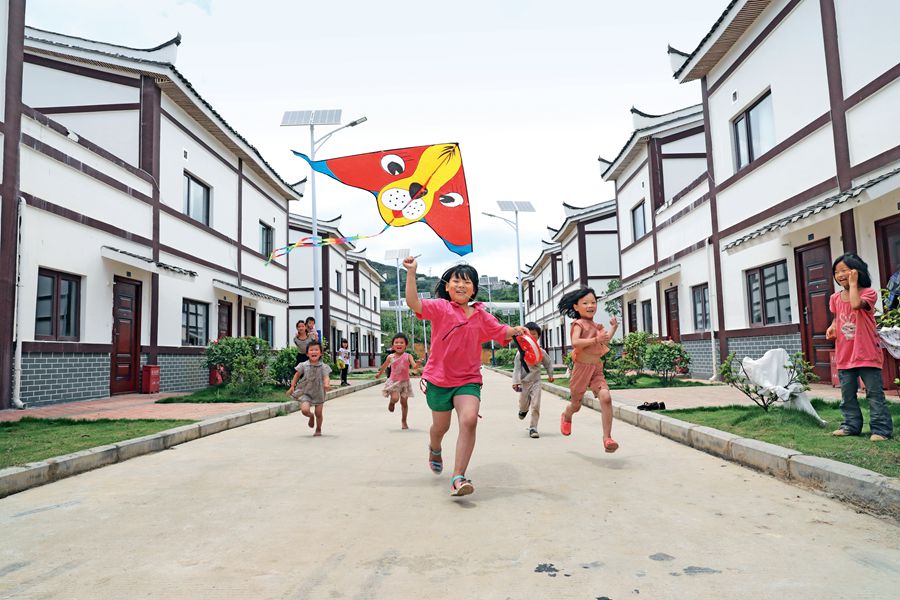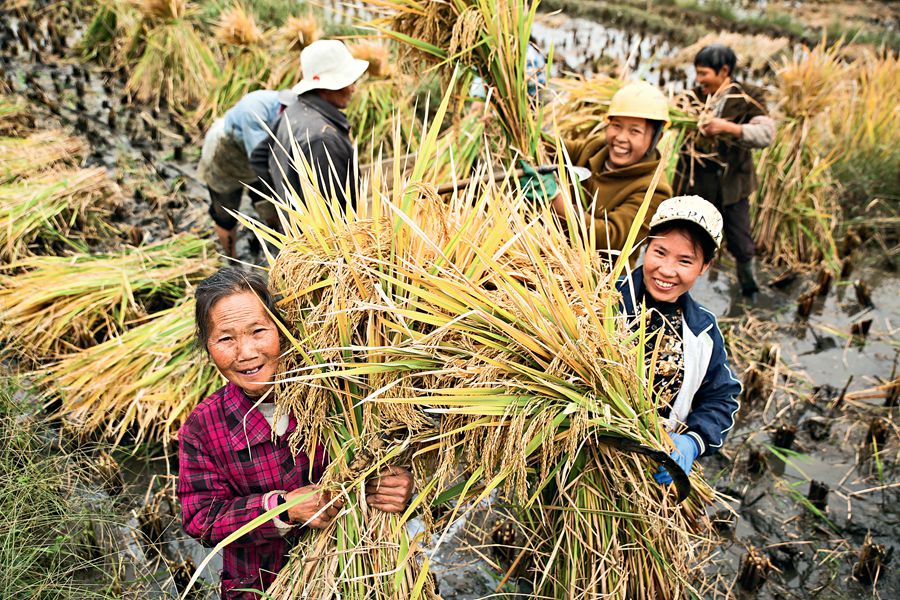POVERTY eradication has always been a common goal of humanity and a challenge to global development. The Communist Party of China (CPC) and the Chinese government have always attached great importance to poverty reduction. The fundamental starting point and goal of their work has been serving the people so that they can live a better life. They have succeeded in finding a way of poverty alleviation and development with Chinese characteristics.
40 Years’ Remarkable Achievements
When the People’s Republic of China was founded in 1949, poverty was prevalent throughout China, especially in rural areas. Its alleviation became a priority in the policies of the CPC and the government. By expanding farmers’ rights to use land, improving rural infrastructure, primary education, and basic medical services, establishing a social security system based on the rural collective economy, and implementing major policies such as building an agricultural technology promotion network, the poverty of rural residents was significantly alleviated, and their living conditions were improved. However, by the current standards, the poverty-stricken rural population in 1978 was 770 million with the poverty headcount ratio as high as 97.5 percent.

On July 4, 2018, residents of Tancheng District, Linyi City, Shandong Province, are working in a kennel production business which brings them better income.
In 1978, China’s reform and opening-up began. The state took economic development as its central task, and began to shift from a planned economy to a socialist market economy, and from a traditional agricultural society to an industrial and modern society. It has since stuck to the road of alleviating poverty through development.
Since the mid-1980s, large-scale, well organized, and planned programs have been carried out, including the Seven-Year Priority Poverty Reduction Program (1994-2000), the Outline for Development-Oriented Poverty Alleviation for China’s Rural Areas (2001-2010) and the Outline for Development-Oriented Poverty Alleviation for China’s Rural Areas (2011-2020) . In 2012, the 18th National Congress of the CPC set the goal of building a moderately prosperous society in all respects by 2020. The Fifth Plenary Session of the 18th CPC Central Committee, held in 2015, set the goal of lifting the rural poor out of poverty as the bottom line of building a moderately prosperous society in all respects. Thus, China has placed development-oriented poverty alleviation in a more prominent position, and adopted the strategies of targeted poverty aid and alleviation, breaking new ground in the work. Rural residents’ income has been on the rise; their living standards have had significant improvements; the number of poor people has dropped a great deal, and China’s rural areas have moved from suffering from widespread poverty to the overall elimination of absolute poverty.
According to the World Bank’s international poverty threshold of US $1.9 (RMB 12.3) per person per day and its statistical data, the number of poor people in China decreased from 878 million at the end of 1981 to 25.11 million at the end of 2013, a sharp decrease of 853 million. The poverty headcount ratio in China dropped from 88.3 percent at the end of 1981 to 1.9 percent at the end of 2013. Over the same period the poverty headcount ratio in the world dropped from 42.3 percent to 10.9 percent. The poverty reduction rate in China is significantly faster than that in the world, and the poverty headcount ratio is also significantly lower than the global average. China has become the world’s first developing country to achieve the poverty reduction goal of the UN Millennium Development Goals, contributing more than 70 percent to global poverty reduction.

Starting from 2018, around 10 million poverty-stricken households nationwide will be relocated in new neighborhoods within two years, as a way of further improving their lives.
Since the 18th National Congress of the CPC, China has mobilized the whole party and the whole of society to fight against poverty, which has achieved remarkable results and made decisive progress. According to the current poverty standard, from 2013 to 2017 China uplifted 16.5 million, 12.32 million, 14.42 million, 12.4 million, and 12.89 million of the rural population out of poverty respectively. It not only reduced impoverished people by more than 10 million per year, but also broke the pattern of decreased poverty reduction after the implementation of new standards. Over the past five years, 68.53 million people in rural areas have been lifted out of poverty, with the poverty reduction rate approaching 70 percent and an average of 13.7 million people lifted out of poverty each year. The poverty headcount ratio also dropped from 10.2 percent at the end of 2012 to 3.1 percent at the end of 2017, with the poverty headcount ratio in 17 provinces falling below three percent.
Global Cooperation to Eradicate Poverty
In the 21st century, poverty still plagues the world and is the primary issue to be tackled in social development. In September 2015, world leaders adopted the 2030 Agenda for Sustainable Development at the United Nations. The Agenda was officially launched on January 1, 2016, calling on all countries to take actions and work towards achieving the 17 Sustainable Development Goals in the next 15 years. Eliminating extreme poverty in all its forms is its primary goal.
According to a World Bank report, the proportion of the world’s poor has dropped to 9.6 percent based on the new international poverty line of less than US $1.9 per person per day. However, eradicating extreme poverty worldwide by 2030 requires countries to attach great importance to the problem, increase input, adopt more effective strategies, and act together.
In the face of many challenges in global poverty control, the process of poverty reduction has been greatly hindered by sluggish economic growth in many countries, by the difficulty in benefitting the poor from the outcome of development, and by the lack of top-level design for special anti-poverty actions. In this regard, China’s experience, proven to be scientific, practical, and internationally applicable in practice, has provided important inspirations to global poverty control efforts.
Firstly, a comprehensive poverty alleviation strategy should be implemented in response to the complex and onerous nature of poverty affecting any developing country. China’s poverty control system adopts targeted measures guided by the needs of the poverty-stricken population, so that the supply of resources effectively satisfies the needs of poverty-stricken people, poverty relief efforts are both comprehensive and precise, and the overall demands of poverty alleviation are efficiently met.

Rice harvest at Xiaotun Village of Dafang County in southwest China’s Guizhou Province.
Secondly, governments should play a leading role in poverty alleviation responding to the general trend of weakening drive from economic growth towards poverty reduction. Economic growth has less or even no driving effect on poverty reduction. Chinese government plays the leading role in guiding the whole process of poverty reduction, including setting targets, intervention, and performance evaluation. China has improved the overall efficiency of government efforts in poverty alleviation through the mechanism of central planning, overall provincial responsibility, and implementation by cities and counties. This experience is universal and applies to any ruling party or government that is determined to reduce poverty.
Thirdly, the mechanism for accurately identifying the poor should be established. This is the basis of targeted poverty alleviation. China has gradually formed in practice and tested on a large-scale a precise identification mechanism that combines a top-down hierarchical responsibility structure with a bottom-up democratic appraisal practice participated in by villagers. It applies to different countries and different poverty populations; therefore, it is helpful in improving the effectiveness of poverty alleviation.
Fourthly, poverty alleviation should be combined with motivation for poor people to improve their situation and educational aid be provided to them. With development as the fundamental approach to poverty eradication, we should emphasize on activating the enthusiasm and initiative of the poor, enhancing their own ability of development and giving full play to their principal role in poverty alleviation. A vital sign of successful development-oriented poverty alleviation is that the people rising above poverty have built up the power of self-development. China always insists on synchronizing poverty alleviation and nurturing the inner drive, constantly developing new modes of participation, and respecting the initiative of the officials and the people in poverty-stricken areas. Poverty alleviation relies on more than aid from outside.
Lastly, in exploring approaches to poverty alleviation, national conditions should be taken into account. China’s experience in poverty alleviation is drawn from long-term practice, absorbing successful international experience in light of local conditions. In a general sense, China’s programs and experience, especially the concept and strategy of targeted poverty alleviation, are globally applicable, and most of its policies, measures, and modes are valuable points of reference for other countries. However, the severity of poverty as well as its features and causes vary in different countries. Therefore, it is necessary to consider local conditions in learning from other countries and building local models.
HUANG CHENGWEI is director and research fellow of the national publicity and educational center for poverty alleviation under the State Council Leading Group Office of Poverty Alleviation and Development.


